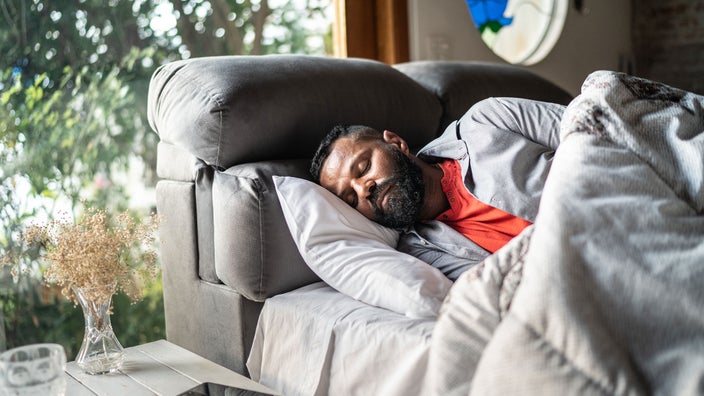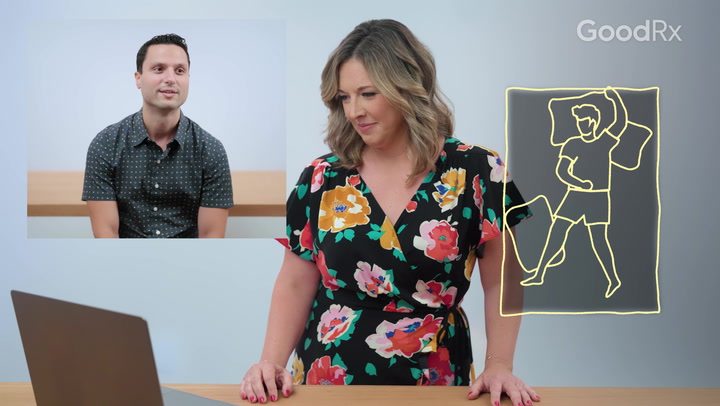
How to Sleep With Neck Pain: The Best Positions, According to Experts
Key takeaways:
Muscle strain, age-related changes, and sleeping in the wrong position may cause neck pain.
Research shows that sleeping on your back or side may ease neck pain.
A medium-firm mattress and a supportive pillow can help keep your neck in a neutral position, preventing new or worsening pain.
Table of contents

A stiff, painful neck can make it hard to get a good night's sleep. And certain sleeping positions can cause or contribute to neck pain. Roughly 30% of the population deals with neck pain every year. So if you're having trouble catching some Z’s with this condition, you're probably not alone.
The good news is that neck pain due to a sore muscle, tendon, or ligament will usually go away in a week or two. But some people develop chronic neck pain, which can come and go for weeks, months, or even years. Knowing the best sleeping positions for neck pain can help you get a better night’s sleep. It may also help you heal faster and prevent long-term pain.
What are the best sleeping positions for neck pain?
Your body needs sleep to heal and recharge. But sleeping in certain positions can cause neck pain, making it hard to get the rest you need. Consider the following sleep postures to help prevent or relieve neck pain.
Search and compare options
1. Sleep on your side
People who slept on their sides were less likely to report neck and back pain, according to a 2019 review. Side sleeping may also be the best option for people who snore, are pregnant, or have digestive problems like acid reflux. In these cases, you'll want to stick to lying on your left side.
Side sleeping helps keep your head and neck aligned with the rest of your body. The key to keeping your head and neck in this neutral position is to find a pillow that isn't too fluffy or too flat. You can also put a pillow between your knees to help maintain your sleep posture.
A 2021 study compared feather and rubber pillows, which are filled with memory or latex foam. The researchers concluded that spring and rubber pillows may reduce neck pain. The height and shape of the pillow, regardless of the material, can affect cervical spine alignment.
You can also get the support you need by rolling up a small towel and placing it inside your pillowcase, underneath your neck. This will fill any low or empty space and help keep your neck properly aligned.
Neck pain sometimes causes soreness or numbness in the arm and shoulder. If that happens, try sleeping on your other side.
2. Sleep on your back
The same 2019 review found that sleeping on your back (supine) may be the next best option for dealing with neck pain. This position can help if you have conditions that make sleeping on your side difficult, such as shoulder pain. Sleeping on your back with a pillow under your knees is also recommended for people with low back pain.
Read more like this
Explore these related articles, suggested for readers like you.
To ensure proper alignment while sleeping on your back, make sure your neck stays straight. As with the side-lying position, you can put a rolled-up towel in your pillowcase for added neck support. Or consider using memory foam, latex, or spring pillows. You should also place a pillow or two under your knees to maintain the natural curve of your spine.
What is the worst sleeping position for neck pain?
In one small study, stomach sleepers reported more neck pain and stiffness than those who slept on their side or back. When you sleep on your stomach, you have to turn your head to one side, so you can’t keep your head and neck neutral. Typically, you hold that angled position for long periods, which can cause pain and stiffness. This sleep posture can also cause improper body alignment that increases the weight on your neck, leading to additional strain.
Experts say you can train yourself to sleep in a better position. Try placing large pillows around your body to help you stay on your back or side and avoid turning onto your stomach while you sleep.
Causes of neck pain from sleeping
Whether you have a sore, stiff neck in the morning or it wakes you up at night, neck pain from sleeping is fairly common. In fact, neck pain affects an estimated 1 in 3 people a year, with women more at risk than men. Here are some common causes of neck pain from sleeping.
Muscle strain
Sleeping in the wrong position can place your neck in an awkward location that strains your muscles. When you sleep on your stomach, for example, your head is turned to one side for long periods. This can cause pain, stiffness, and difficulty turning your head in the morning.
Using the wrong pillow can also cause muscle strain. Whether it is a memory foam pillow or a feather pillow, make sure the pillow is not too high or too low. It should keep your head in a straight or neutral position and support the curves of your neck.
Lastly, poor posture during the day, such as slouching at the computer, can cause muscle strains that cause neck pain at night.
Stress
Stress and anxiety can cause people to keep their muscles tight, both at night and throughout the day. That tension could result in painful muscle knots and spasms in the neck and shoulders. It could also cause neck pain and stiffness while sleeping.
Previous injuries
If you have injured your neck in the past, sleeping in the wrong position or using the wrong pillow can cause neck pain while sleeping. One common neck injury is whiplash. It happens when your head forcefully jerks forward and then back, usually in a car accident or while playing a sport. It damages your muscles and connective tissues, as well as your spinal discs, nerves, and vertebral joints.
Age-related changes
As you age, wear and tear on your spine can cause musculoskeletal problems that affect your neck. Examples include osteoarthritis, herniated discs, and pinched nerves. Degenerative changes can also cause spinal stenosis. This occurs when the spaces in your spine narrow, putting pressure on surrounding nerves. All of these conditions can contribute to neck pain while sleeping.
TMJ disorders
Those with temporomandibular joint (TMJ) disorders often clench and grind their teeth at night and have jaw pain and popping. But TMJ doesn't just affect your jaw. In research studies, 70% of people with TMJ also had neck pain. If you wake up with jaw and neck pain, TMJ treatment may help alleviate both.
Lack of sleep
It’s possible that not getting enough quality sleep may also lead to neck pain. And you might not get enough sleep because of your neck pain at night. This can result in a vicious cycle. Whether it is sleep position or another factor, try to pinpoint the cause of your neck pain at night so you can get better sleep.
Tips to help you relieve neck pain after sleeping
If you have chronic or recurring neck pain, it is important to determine the cause and make changes to address it. Consider these tips to improve your sleep quality.
Replace your old mattress and pillows. It’s a good idea to replace your mattress every 6 to 8 years, or when it starts to sag or feel uncomfortable. And swap out your pillows every 1 to 2 years. Studies show that a medium-firm mattress may promote proper spinal alignment and better sleep quality. One small study found that sleeping on a memory foam mattress with medium firmness reduced pain and improved sleep.
Use a hot or cold compress. Both heat and ice can help decrease neck pain. Cold helps decrease inflammation and is the most helpful in the first 48 to 72 hours following an injury. Warm compresses or heating pads help increase circulation and relieve muscle tension or spasms.
Adjust your workstation. If you work at a desk, make sure your workstation is set up properly to keep your head, neck, and spine aligned. Sitting in a supportive chair with your desk and computer at the correct height can promote healthy posture and help you avoid aches and pains.
Do gentle stretches and targeted exercises. Take breaks to move around throughout the day. And do gentle neck stretches that move your head through its full range of motion (side to side, up and down, circles). This helps keep your neck muscles loose and can prevent knots.
Try stress-relieving practices. Make stress-relieving techniques part of your routine. You can book a massage, meditate, or try yoga to decrease daily stress. Activities such as walking in nature or listening to your favorite song can also help you relax. Consider talking to a therapist for additional help managing stress.
Use pain relievers when necessary. Try a short course of over-the-counter pain relievers such as ibuprofen (Advil, Motrin), acetaminophen (Tylenol), or aspirin. You can also talk to your provider about prescription pain relievers.
Try physical therapy. A physical therapist can evaluate your posture and recommend strengthening exercises to correct muscle imbalances. They can also use various techniques to reduce pain and promote healing. Hands-on treatment, including trigger point release and massage, can also help.
When should you see a doctor about neck pain?
Most neck pain will go away on its own. However, in some cases neck pain can be a sign of other medical conditions or more serious injuries.
If your neck pain doesn’t improve after a week of at-home treatment, experts recommend seeing a healthcare provider. You should also see a provider if you have:
Neck pain that gets worse when you lie down
Pain that wakes you up at night
Pain that doesn’t get better for a few hours with over-the-counter pain medication
Numbness, tingling, or weakness in your arm or hand
Neck pain that started after an injury, such as a car accident or a fall
Swollen lymph nodes in your neck
Neck pain along with difficulty swallowing or breathing
Seek emergency medical care if you have any of the following symptoms:
Neck pain, along with jaw pain, arm pain, shortness of breath, sweating, or nausea, which can all be signs of a heart attack
A headache, fever, and neck stiffness, which could indicate meningitis
The bottom line
Sleeping in certain positions can cause or worsen neck pain. People who sleep on their side or back may have less neck pain and stiffness than those who sleep on their stomachs. Other factors –– such as supportive pillows and a medium-firm mattress –– may also ease neck pain and improve sleep quality.
Why trust our experts?



References
American Heart Association. (2022). Warning signs of a heart attack.
Ancuelle, V., et al. (2015). Effects of an adapted mattress in musculoskeletal pain and sleep quality in institutionalized elders. Sleep Science.
Auvinen, J. P., et al. (2010). Is insufficient quantity and quality of sleep a risk factor for neck, shoulder and low back pain? A longitudinal study among adolescents. European Spine Journal.
Cary, D., et al. (2019). Identifying relationships between sleep posture and non-specific spinal symptoms in adults: A scoping review. British Medical Journal Open.
Cary, D., et al. (2021). Examining relationships between sleep posture, waking spinal symptoms and quality of sleep: A cross sectional study. Public Library of Science One.
Chun-Yiu, J. P., et al. (2021). The effects of pillow designs on neck pain, waking symptoms, neck disability, sleep quality and spinal alignment in adults: A systematic review and meta-analysis. Clinical Biomechanics.
Cohen, S. P. (2015). Epidemiology, diagnosis, and treatment of neck pain. Mayo Clinic Proceedings.
Foley, L. (2023). When should you replace your mattress? Sleep Foundation.
Fountain, L. (2023). How often should you replace your pillows? Sleep Foundation.
Institute for Quality and Efficiency in Health Care. (2019). Neck pain: Overview. InformedHealth.org.
Kempf, B., et al. (2012). Association between the side of unilateral shoulder pain and preferred sleeping position: A cross-sectional study of 83 Danish patients. Journal of Manipulative and Physiological Therapeutics.
MedlinePlus. (2022). Neck pain.
MedlinePlus. (2022). Problems sleeping during pregnancy.
National Institute of Arthritis and Musculoskeletal and Skin Diseases. (2020). Spinal stenosis.
Person, E., et al. (2015). A novel sleep positioning device reduces gastroesophageal reflux. Journal of Clinical Gastroenterology.
Radwan, A., et al. (2015). Effect of different mattress designs on promoting sleep quality, pain reduction, and spinal alignment in adults with or without back pain; Systematic review of controlled trials. Sleep Health.
Shoen, S., et al. (2022). Sleeping on your stomach - is it bad for you? Sleep Foundation.
Silveira, A., et al. (2015). Jaw dysfunction is associated with neck disability and muscle tenderness in subjects with and without chronic temporomandibular disorders. BioMed Research International.
University of Maryland Medical Center. (n.d.). A patient's guide to cervical radiculopathy.
Yeomans, S. (2020). 2 ways a rolled towel can reduce neck pain. Spine Health.





























